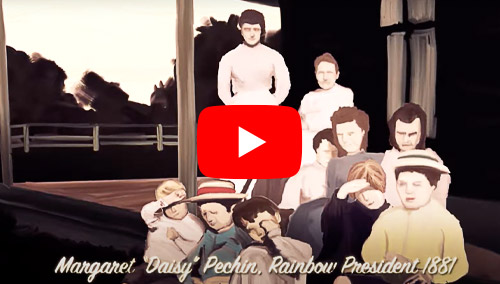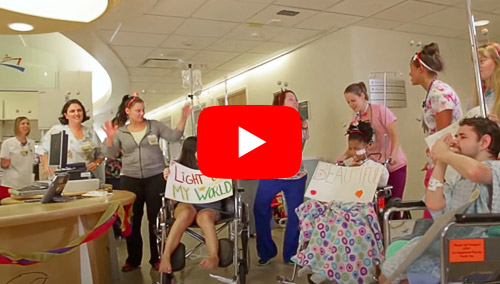University Hospitals Rainbow Babies & Children’s Hospital Has Been Caring for Children More Than 100 Years
The story of University Hospitals Rainbow Babies & Children’s Hospital is really the story of two hospitals – Rainbow Hospital and Babies and Children’s Hospital. Rainbow Babies and Children’s Corporation is the direct descendant of the independent Rainbow Hospital, which joined Babies and Children’s Hospital of University Hospitals of Cleveland in a new building constructed in 1971.
The story of the hospitals actually began over 100 years ago, in 1887, when nine young women from prominent and wealthy families came together on Thanksgiving Day to form a Circle of King’s Daughters, a national sisterhood whose mission was “a perfect determination to relieve suffering.” Calling themselves the Rainbow Circle of King’s Daughters, they met to discuss how they could help poor children in Cleveland. The Rainbow Circle’s vision was to provide a place for sick children to convalesce. The young women began making plans and raising money through charity balls and bed subscriptions.
Rainbow Cottage was opened in 1891 on a poultry farm at the north end of Doan Street (East 105th Street) in Glenville on a bluff overlooking Lake Erie. Rainbow Cottage cared for 32 children that summer. By 1896, Rainbow Cottage was incorporated and remained open all year round. In 1900, Edith Hale Harkness and her husband William gave $25,000 for the construction of a three-story brick cottage on Mayfield Road in South Euclid. When this building was destroyed by fire in 1904, another site was leased, Novak Villa (1905), on Green Road.
As the years passed, Rainbow limited its admissions to convalescent children with surgical histories to avoid duplication of efforts undertaken by other local agencies. In 1914 Rainbow Cottage changed its name to Rainbow Hospital for Crippled and Convalescent Children. A nursery school, sponsored by the Kiwanis Club, one of the first established in association with a hospital, opened in 1923. In 1927 Rainbow Hospital participated with University Hospitals in a $6 million capital campaign that enabled Lakeside Hospital to move to University Circle and provided Rainbow with a completely new modern hospital in South Euclid. Dedicated in 1928, the new Rainbow Hospital remained at the Green Road site until its move to University Circle in 1971. In 1937, a three-wing classroom was added to Rainbow Hospital and named the Bingham School in honor of Charles W. Bingham, the father of Mrs. Dudley S. Blossom, Sr., and Congresswoman Frances Payne Bolton.
As with Rainbow Cottage, Babies and Children’s Hospital began with the vision and commitment of people who cared about the health needs of Cleveland’s children – especially the poor. Dr. John Lowman, a Lakeside Hospital physician, representatives of the Milk Fund Association (1899) and the Visiting Nurse Association, Dr. Edward F. Cushing, Lakeside Hospital’s “physician to the children’s department,” and community leaders came together to establish the Infants’ Clinic (located at the Central Friendly Inn) in 1906. It was incorporated the following year as the Babies Dispensary and Hospital. With the opening of a new building (at 2500 East 35th Street) in 1911 containing clinics and a milk laboratory, the dispensary concentrated on the care of sick babies with well-child care provided by a network of branch clinics throughout the city.
In the 1920s, Babies and Children’s Hospital joined with the Maternity Hospital in a fund-raising drive to build new hospitals in University Circle. The new Babies and Children’s Hospital opened in 1925. In that same year, Babies and Children’s Hospital joined with Lakeside Hospital and Maternity Hospital to form University Hospitals of Cleveland (1925). A year later in 1926, Rainbow Hospital affiliated with University Hospitals. During the 1950s, 1960s, and early 1970s, physicians at Babies and Children’s Hospital conducted pioneering research in cystic fibrosis, maternal and infant bonding, pediatric cardiology and orthopedics as well as sought new ways to deliver care – such as the development of the PICU and NICU. A renewed approach to family-centered care was inaugurated in the early 1970s.
In 1971, a new children’s hospital was built housing both Babies and Children’s Hospital and Rainbow Hospital. In 1974 both hospitals were combined under one Board of Trustees (what had been the Rainbow Board) in a legal arrangement that ended the separation between the operations of Rainbow Hospital and Babies and Children’s Hospital.
Construction began on a new addition to the 1971 structure in 1985. Later, a new 190-bed Leonard and Joan Horvitz Tower, the most technologically-advanced and family-oriented pediatric facility in the nation, was dedicated on April 5, 1997, and opened on April 15, 1997.
In 1998 the Rainbow Babies & Children’s Hospital Board of Trustees voted to change their organizational structure to a tax-exempt, charitable supporting organization of Rainbow Babies & Children’s Hospital of the University Hospitals of Cleveland. At that time, the name of the newly restructured organization was Rainbow Babies & Children’s Corporation. The legal reorganization achieved better alignment between the current mission of the Rainbow Board and its legal structure.
During the next several years, the Board devoted time to clarifying the mission statement of the Board as it relates to being a supporting organization. In 2004, the Board adopted the following statements of mission and vision, which underpin all Board goals, strategies and activities.
At the May 2005 Annual Meeting, the Board changed the name of the organization to Rainbow Babies & Children’s Foundation.
Contact Us
UH Rainbow Babies & Children’s Foundation
11100 Euclid Ave., Mail Stop MCCO-5062
Cleveland, OH 44106
Maria Russo Young, Manager
Email: MariaR.Young@UHhospitals.org
Phone: 216-844-1513
Give Today
Make a gift online to support the Rainbow Babies & Children’s Foundation.
Support Family & Child Life Services
Donate today to the UH Rainbow Babies & Children’s Hospital Family & Child Life Department.




